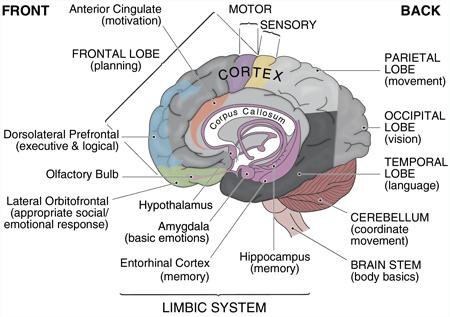By Shawrna Sen
Before we begin to consider certain substantial differences regarding the female and male brain, let’s cover some basic facts regarding the brain. [3]
- An adult brain weighs about three pounds and makes up only 2% of a person’s weight. 85% of the brain’s weight is due to the cerebrum.
- The brain is composed of 75% water, so not sufficiently hydrating yourself negatively impacts your brain function.
- Your brain will triple its size within the first year of life. However, the brain continues to grow until your mid-20s when it is fully mature. The brain develops from the back to the front.
- The human brain contains approximately one hundred billion neurons, which is about the number of stars in our Milky Way galaxy. However, neurons make up only 10% of the entire brain.
- The brain does not have any pain receptors, therefore it can not feel pain.
- The human brain begins to shrink with age after a person reaches the mid-50s.
- An average person has about 12,000 to 60,000 thoughts per day, of which about 80% are negative.
- The brain uses 20% of the oxygen and blood in the body. This percentage changes based on the intensity of your thoughts; therefore it could use up to as much as 50% of the oxygen and blood of the body.
- The brain can produce about 12 to 25 watts of electricity, which is enough to light a small light bulb.
- The majority of the brain consists of fat, which is why omega 3 fatty acids are crucial to brain health.
The stereotypes used to separate the social roles of women and men—and establish each gender’s collective capabilities—have been challenged from time immemorial. Now neuroscience suggests it’s time to find out the truth.

Proving that there are meaningful differences between the male and female brain Has been a huge dilemma in the field of neurology, and for science in general! Recent research has demonstrated just a few differences within human brains based on gender. To find out more, continue reading.
The few key points that support the idea of neurological differences related to gender are primarily due to disorders linked more specifically to the brains of one gender over another. For example, the female brain is more frequently diagnosed with disorders such as depression, and anxiety, along with higher rates of Alzheimer’s disease. Male brains are bigger than female brains which, however, does not impact the intelligence quotient, or IQ. [1]
A 2018 project that studied 2,750 female and 2,466 male brains found anatomical differences. Female brains were found to have thicker cortices, while male brains were larger in structure and had bigger cerebral regions. [1]
The male brain has 6.5 times as much “grey matter,” brain tissue which contains most of the neuronal cell bodies. The female brain has 10 times as much “white matter”—which are tissues through which messages pass—and whose white color is due to myelin. Myelin is made up of proteins and fatty acids which act as an insulating layer around the nerves. The difference in levels of grey matter and white matter appear to be why men focus best on a single task, and women are better at multitasking. Another difference between them is that female brains have signals transmitting or interacting from both sides of the brain, while male brains typically have signals communicating from the back to the front within the same cerebral hemisphere. Women’s brains have a greater blood flow in certain regions than male brains. Moreover, having a larger hippocampus than men allows women to better express themselves emotionally. Having a larger amygdala than women may be the reason why men respond to emotional stress physically. [2]
Although these differences exist, there is no guaranteed way to determine a person’s gender by looking only at the brain. Also, there is no individual that has a brain that conforms to every attribute associated with either a male or female brain.
Credits:
- https://www.youtube.com/watch?v=z5c7ubF0u-U
- https://www.youtube.com/watch?v=q9 EbaY OSzk
- https://www.dentinstitute.com/posts/lifestyle-tips/22-facts-about-the-brain-world-brain-day/
